The Winter Garden – beautiful bark
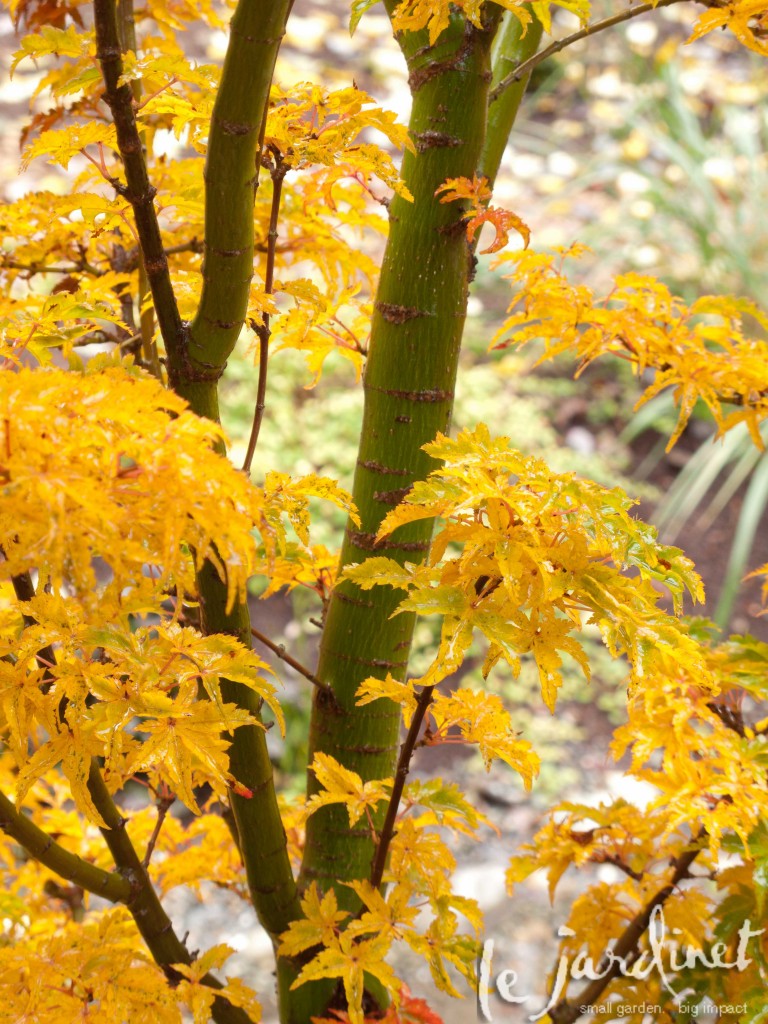
'Lions head' maple is best known for its tufty foliage reminiscent of a lions mane but the smooth olive green bark is equally beautiful
As leaves fall from the trees it is tempting to consider them merely naked statues in the landscape until they are clothed once again in foliage. It is also tempting to stay inside by the fire rather than explore the garden! Yet the texture and color of bark and stems can add significant interest to the landscape at this time of year. Careful placement will allow you to enjoy them from your armchair but can also be good motivation to find your boots and scarf to take a closer look. It’s amazing how even a brief stroll around the garden can lift the spirits.
Here are some of my favorite trees and shrubs that exhibit interesting bark for both the landscape and containers.
River birch (Betula nigra), often multi stemmed, has shaggy bark which peels off in papery curls, revealing the salmon beneath.'Heritage' is one of the best full size cultivars. Although it does not need wet soil it copes well with it, making it a good choice for my garden! We have planted a group of three in a low spot which fills with water every winter. For smaller gardens the cultivar ‘Little Fox’ (syn. ‘Little King’) may be a better option, growing to 12-15’ rather than towering to 40’ like the species. Full sun or light shade. Hardy in zones 4-9
The vivid lightning bolt patterns in shades of grey, orange and red sets the exfoliating bark of Japanese stewartia (Stewartia pseudocamellia) apart. This special tree has many virtues – it is relatively pest and disease free, has exquisite white camellia-like blossoms in mid-summer when few other trees are in flower, and greets autumn with shades of red and purple. A gorgeous specimen tree growing to 40’ tall and 20’ wide. Does best with some afternoon shade. Zones 5-8
A recent addition to our garden has been the paperbark maple (Acer griseum). The striking cinnamon colored peeling bark is a standout in the winter landscape, especially emerging from a blanket of snow. At just 18’ tall and 15’ wide it is suitable for smaller landscapes where its fresh green foliage can be enjoyed in spring and summer before turning to vivid sunset shades in fall. It copes well with sandy or clay soil, full sun or dappled shade and is hardy in zones 4-8.
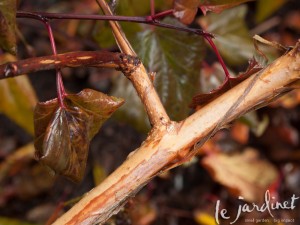
As the last few leaves fall to the ground the colorful stems of 'Coppertina' ninebark become visible
I love ninebark (Physocarpus opulifolius cultivars) almost as much as our deer! With foliage in shades of green, gold, copper or deep burgundy and sizes ranging from 4’ to 10’ I can enjoy many of these deciduous shrubs in containers or the border.
The larger cultivars such as ‘Diablo’ and ‘Coppertina’ can be left to grow freely or cut down and thinned out to keep to a smaller size. They are remarkably adaptable, coping well with moist conditions in either full sun or partial shade. Clusters of white spring flowers are followed by glossy red berries and fall color ranges from rich mahogany (‘Diablo’ and ‘Little Devil’) to orange (Dart’s Gold). There are therefore plenty of reasons to use them in your garden, but they have another great attribute – the outer brown bark of these multi-trunked shrubs peels away to reveal strips of creamy white beneath.
Include the compact ‘Little Devil’ in a container year round and you can enjoy these colorful branches throughout the winter. In the landscape larger specimens can be best appreciated if they are fronted by herbaceous perennials so that their winter glory is revealed when the perennials die down. Zones 3-8
Japanese maples are well known for their fall color but many also have striking bark, the coral bark maple (Acer palmatum ‘Sango-kaku’) being perhaps the best known. Two others I enjoy in my own garden are the ‘Lions head’ maple (Acer shishigashira) with its smooth olive green bark, so beautiful against the yellow and orange fall foliage and a welcome addition to my woodland garden. I also have ‘Arakawa’ (Acer palmatum ‘Arakawa’) which means ’rough bark’ – an unusual corky appearance which presents a new texture.
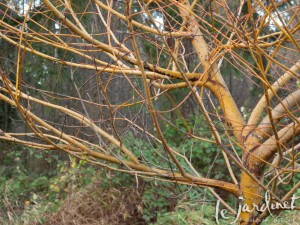
Despite deer and flooding our weeping willow is thriving and brings great color to the winter landscape
The first tree I planted in this garden was a golden niobe willow (Salix alba 'Tristis'). I was still coming to terms with the unwelcome surprise that our new garden was a 5 acre lake in winter and wondering how on earth I could realize my dream of a beautiful garden. Sheer stubbornness dictated that this was going to be a case of ‘right plant, right place’ so I looked for a tree that could cope with several inches of standing water for most of the winter. Not only that but it had to deal with saturated soil for most of spring before it turned into concrete each summer. Amazingly this weeping willow has come through and is doing great. Actually it is somewhat ‘poodled’ thanks to our deer who eat everything they can reach giving it a ridiculous haircut that looks like a monks tonsure. If you can get over the somewhat truncated ‘weeping’ part then you will appreciate the bright yellow stems and bark in the winter which contrast well against the dark evergreen backdrop.
Others trees and shrubs with great bark;
Shrub dogwoods (red, yellow or multi-colored stems)
'Little Gem' vine maple (dark red)
‘Fine Line’ buckthorn (brown with tiny white spots)
Snake bark maple (green with snakeskin markings)
Paperbark cherry (glossy mahogany)
What trees and shrubs do you have in your garden with interesting bark and branches?
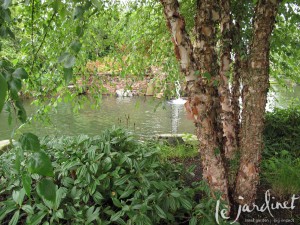
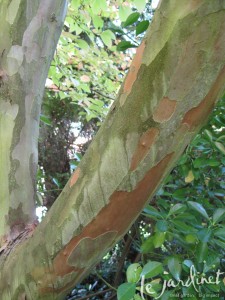
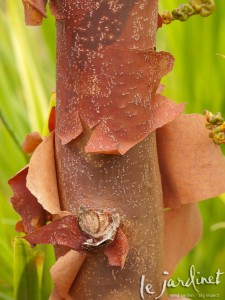
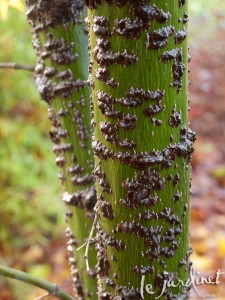
You have shown the cold months need not be so dreary. Winter is the perfect season to appreciate great bark. My garden definitely does not need another Japanese maple, but now you have shown me Arakawa bark! Fascinating! Sigh…I am entirely too greedy. I want them all!
I'm sure you can squeeze it in Deb!
Very nice photos of bark. While Acer griseum always catches my attention, I often fail to notice the bark of smaller plants like Psysocarpus.
Thanks Jordan. Winter strolls around the garden have helped me appreciate these details.
Winters are long here and so it is nice to have trees with winter interest. Most of the trees were here when he moved in and so their choice was not mine. Other than ninebarks shrubs which I did add, I not sure I have any interesting barks. I have added a few Japanese Maples, but did not realize that their bark had such potential to be attractive in the colder months. I like the green bark of the 'Arakawa'.
Jennifer, I became more appreciative of maple bark after growing a few in containers where I saw them close up throughout the winter. Both the lion's head and Arakawa maples started their life with me that way, moved house once and finally got planted in the ground this year!
Certainly Pinus bungeana is wonderful in the winter-plant now for your grandchildren!
Ruth – very true! I should add it to the 3' horse chestnut tree that I have planted for the same grandchildren!
Kerria japonica has wonderful smooth lime green twigs that contrast beautifully with the lemon yellow fall foliage; and the green twigs really call attention to themselves in the wintertime.
I love that scrambler Dan! I have underplanted it with the golden grass Carex 'Bowles' Golden' which being evergreen makes a great year round companion
[…] and fall foliage. It takes serious restraint to look beyond those and seek plants that offer great bark, interesting silhouettes, winter flowers and bright […]
Great survey of some of the best. Other good barks in my garden: climbing hydrangea, oakleaf hydrangea, and sycamore off the top of my head. Deer don't eat my ninebarks in PA or ME. Are they white-tailed deer?
Carolyn, I always forget about sycamore – thank you. I do love the peeling bark of those two hydrangeas too.
I believe we mostly have black tailed deer in our area but like all deer are opportunists and cause almost as much damage with their rutting as they do by munching